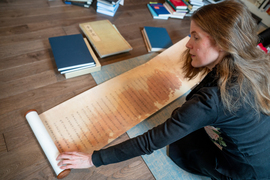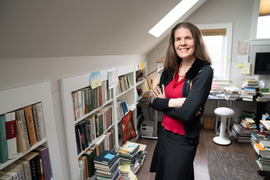Nuns writing fine poetry. Centuries-old joke books. An epic travelogue ending with a visit to Genghis Khan. These are just a few things readers can experience through the new Hsu-Tang Library of Classical Chinese Literature, published by Oxford University Press.
The series is modeled on the Loeb Classical Library, which debuted in 1912 and features about 500 titles of Greek and Roman literature, in their distinctive red and green covers. The Hsu-Tang Library of Classical Chinese Literature series is starting with five titles, under the supervision of founding editor-in-chief Wiebke Denecke, the S. C. Fang Professor of Chinese Language and Culture in MIT’s literature section. The aim is to bring these classic texts, from the first millennium BCE through the early 20th century, to the world, in engaging bilingual editions. There will be four more new titles next year, with dozens lined up after that.
The series benefactors are Oscar Liu-Chien Tang and Agnes Hsin Mei Hsu-Tang, whose family has also been MIT benefactors and has a notable record of philanthropy for institutions and programs in the arts, humanities, and education. MIT News talked with Denecke about the ambitious new book series.
Q: What is the Hsu-Tang Library of Classical Chinese Literature?
A: This is a library of classical Chinese literature, covering three millennia, from what is now China and from many other places. Just as Latin was the lingua franca in Europe, classical Chinese was the lingua franca of writers in East Asia, so we include authors from Japan, Korea, and Vietnam. The editions are bilingual, Chinese on one side of the page and English on the other.
It belongs to a certain type of project that you could call endowed bilingual libraries. This started 100 years ago with the Loeb Classical Library of classic Greco-Roman literature. A decade ago, the Murty Classical Library of India was launched, and now here we have a new library of classical Chinese literature. It is a great moment for world literature.
We publish translations that are both solidly scholarly and eminently readable. Our associate editor is Lucas Klein, who has a vision of literary magic that makes words sparkle — it’s something he has really emphasized.
Our donors, Agnes Hsin Mei Hsu-Tang and Oscar Liu-Chien Tang, are particularly interesting. Agnes Hsu-Tang is the descendant of Xu Guangqi, who was co-translator with Matteo Ricci, an Italian Jesuit missionary in the 17th century, of Euclid’s “Elements.” Agnes has another great ancestor, Ji Yun, who compiled one of the greatest encyclopedias of the world, in the 18th century. It’s not just somebody from the Chinese world supporting this, but there’s a family lineage of translating knowledge onto a global stage, a symbol of East-West cultural exchange.
Q: What can we discover, or rediscover, about Chinese-language literature through this library?
A: I think it’s an important moment for the humanities generally. The Loeb Library was established when James Loeb himself said the humanities were being neglected more than at any time since perhaps the Middle Ages. Overall, we have a three-pronged strategy: First, we try to make the canonical new. Then we go beyond what anglophone readers might have heard about Chinese literature. For instance, we have three joke collections, in “The Misadventures of Master Mugwort.” In China, joke collections were very popular, and there’s a lot of political satire in there. But there is a common prejudice that China lacks satirical literature. Third, the series emphasizes that there is more than 2,000 years of common cultural heritage in East Asia. That’s a real message right there.
We publish works that are very surprising, such as “An Anthology of Poetry by Buddhist Nuns of Late Imperial China.” Many of these are first translations. We wanted a voice of the female experience, often in very precarious times. Some nuns were from elite ranks and had lost their husbands. Others were orphaned. It’s a real archaeology of female voices.
It's a very good antidote to the idea that nuns were confined. Quite to the contrary, they made relationships they never could have in a household. They were writing poetry and painting, and it’s very empowering. One such example is Shangjian Huizong’s 17th-century poem, “Village Life.” Her husband died in prison, and she wrote three volumes of poetry, including these lines:
“Living here impoverished / I’ve lost all taste for ornaments … / The face of the woman in my mirror / is a flower that knows emptiness”
So what is amazing here? Obviously as a nun she was impoverished. The ornaments are hair ornaments, and it goes with a literary tradition in China to write about women in a boudoir — usually written by males, but here the boudoir implies self-reflectivity. The flower is a natural ornament; it also knows that emptiness accompanies the idea of enlightenment, in the Buddhist sense. So, she turns around boudoir imagery, saying she realizes in the symbolic mirror that she has gained enlightenment. These lines have incredible literary value.
Q: Another one of the first five volumes is “Daoist Master Changchun’s Journey to the West,” a firsthand account of a visit to Genghis Khan by a Chinese traveling party on a long diplomatic trip. Surely there are not many texts like this. What is it about?
A: This is written by a disciple of a Daoist patriarch who was summoned by Genghis Khan in the 1220s, when the Mongols were rushing through the continent. They basically emerged from nowhere, didn’t have a lot of history or writing behind them, and shaped world history. There are so few eyewitness sources, it’s amazing to have a travelogue with so much detail. It’s also made special by all the poetry in it, which in the Chinese tradition was always the main medium of experiencing reality and expressing it.
In this text, poetry becomes a way to cope with this travel experience: You start in China, go to Central Asia, like to the city of Samarkind, and encounter different people, different plants, Islam, sweet melons, and people drinking from glass vessels never seen in China. It’s a way to familiarize and exoticize at the same time. And the writer observes a person — we know today it’s a muezzin — lead in “petitioning heaven” for the Muslim prayer. This is an encounter with Islam, though he doesn’t have a real concept of that.
On the other hand, Genghis Khan is intensely interested in the Dao — or at least that’s how it’s depicted. The first three times they meet, the conversation is always about the Dao. The Chinese want to believe the other side is interested in them. Finally, this is also hagiographic text, a sacred eulogy of this patriarch, and it’s a process of getting political capital out of the connections with Genghis Khan.
Through all of this, we are really trying to develop what we call the Hsu-Tang Library style: smartly scholarly, where you feel there’s something gained in translation.











